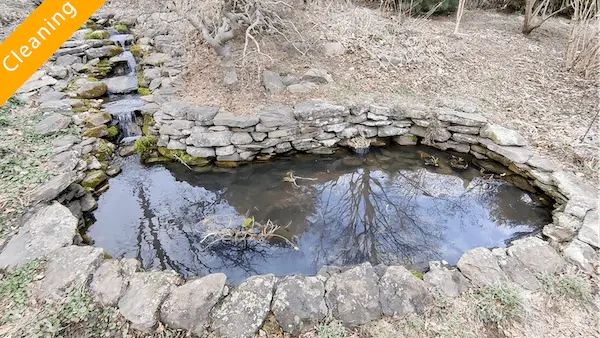Just like indoor fish tanks, ponds have regular upkeep that must be performed as part of their maintenance. Due to its outdoor nature, ponds are exposed to the elements more than fish tanks and are slightly harder to maintain. However,advancements in technology such as pond skimmers and pumps have made maintaining a pond easier than ever before.
In order to account for water lost through evaporation, ponds need to be routinely topped off with the garden hose. This ensures that the pond is operating at its maximum water volume which eliminates the chance of the pump running dry and creates a more stable habitat for the fish. An easy way to keep the pond automatically topped off is to get an auto-fill installed inside the skimmer of the pond. Pond auto-fills are connected to your outdoor faucet and use a floating buoy to control the output of water. When the water level lowers, the buoy drops, allowing the water from the faucet to fill the pond back up until the water level reaches that of the auto-fill.
If a pond is equipped with a skimmer, debris such as leaves and twigs that fall inside the pond will make its way inside the skimmer basket, preventing it from settling at the bottom of the pond or clogging the pump. In this case, the skimmer basket should be dumped periodically to prevent the basket from accumulating enough debris to potentially reduce water flow to the pump.
If a pond is not equipped with a skimmer, a skimming net should be used to manually skim debris off the surface of the pond.
Overfeeding the fish is the number one source of bioload inside a pond. The ecosystem of established ponds can usually handle the added bioload from uneaten fish food however there is always a chance that the amount could exceed what the pond can handle and throw off the balance of the ecosystem. Uneaten pellets and fish waste have the potential to cause unwanted algae blooms and extreme plant growth. Just like debris, uneaten pellets should be removed with the skimming net before they have a chance to dissolve and become fuel for algae.
Aquatic plants are vital components to the ecosystem of a pond. They not only look good, but also naturally filter the water and keep algae levels down. Plants reduce algae levels by using up the nutrients that would otherwise be used as fuel by algae. Plants such as water lilies can also provide shade and cover for both the pond and the fish.
Fish behavior is a good indicator of the overall health of the pond. If the fish are suddenly acting strange or out of character, there is most likely something wrong with the water and it should be looked into futher.
Fish gulping for air near the surface is a strong indicator of low oxygen levels in a pond. This happens most often during the summer months in shallow, stagnant ponds. Compared to cold water, warm water holds less dissolved oxygen so aerators and fountains can be especially beneficial during the summer months.
Erratic swimming is often an indicator of high pH levels. Large water changes with well water often induces this behavior because well water tends to be high on pH.
